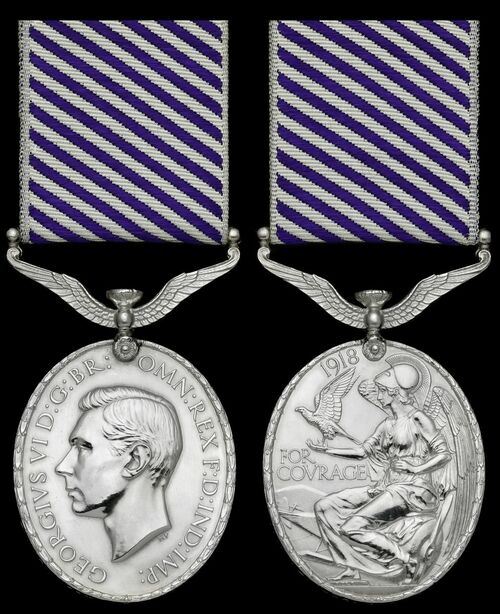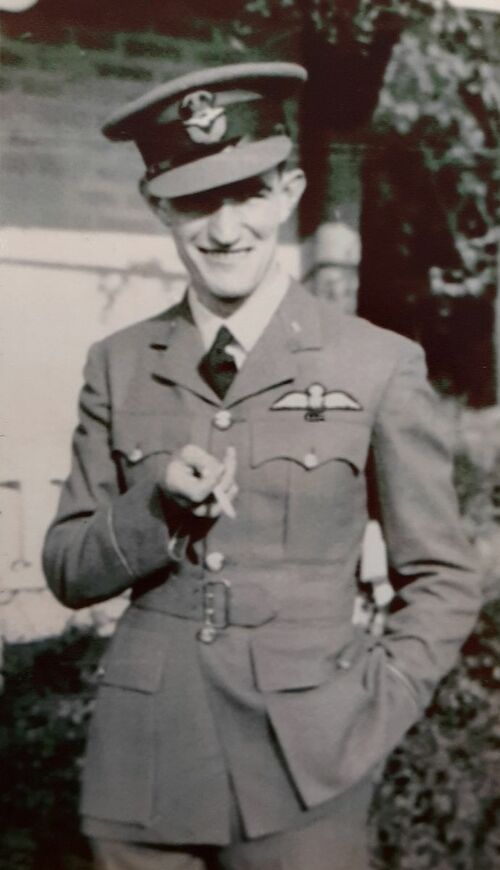Auction: 23111 - Orders, Decorations and Medals - e-Auction
Lot: 955
A superb ‘attack on the Scharnhorst’ D.F.M. awarded to Pilot Officer J. R. Topping, Royal Air Force Volunteer Reserve, for his daring low-level attack upon the legendary German pocket Battleship in Brest harbour he was later tragically killed in action during Operation Fuller on 12 February 1942
Distinguished Flying Medal, G.VI.R. (741484. Sgt. J. R. Topping. R.A.F.), good very fine
D.F.M. London Gazette 23 September 1941, the original citation states:
‘Sergeant Topping has captained an aircraft on 31 operational sorties which have included 10 “Gardening” operations off the coast of France and Germany and 21 bombing raids on the heavily defended Naval yards of the enemy and the industrial cities in the Rhur. His consistent skill and courage have earned him a considerable measure of success. On the night of 4th April, 1941, he carried out a daring low-level attack on the ”Scharnhorst” in Brest Harbour and was only 50 feet above sea-level before pulling out of the dive in which his aircraft was hit by tracer and his Navigator wounded. This N.C.O. is a pilot whose skill, courage and conscientiousness have been outstanding throughout his service in the squadron and his reliable execution of his operations and ground duties have undoubtedly been an example to other members of the squadron.’
John Robert Topping was born on 12 February 1918, the son of Thomas and Annie Topping of Bedford and joined the Royal Air Force Volunteer Reserve being posted to the Central Training School, Finningley. Fully qualified for operational flying Topping joined No. 106 Squadron as Sergeant (Pilot), still flying from Finningley on 2 October 1940. Poor weather prevented the Squadron from much flying throughout the winter of 1940 however were possible they performed ‘Gardening’- minelaying- missions over the channel.
Topping’s first major raid was over Cologne on 3 March 1941, the Squadron operations book noted a heavy concentration of searchlights but limited flak. Despite that one aircraft- they flew Hampton’s- failed to return from the raid, it was to prove the first of many. Further raids were launched on Hamburg and Bremen both of which proved successful, they rounded out the month with further gardening missions.
While Topping was gathering operational experience Scharnhorst had been at sea, hammering Allied merchant shipping. Steaming to the port of Brest for repairs to her smoke stacks Scharnhorst was reported there by the French Resistance agent ‘Hilarion’- the codename of Lieutenant Jean Phillipon- and the R.A.F. was given the task of preventing her from putting to sea again. As 106 Squadron had been mining the area to prevent the escape of the vessels, they were the natural choice for attack.
The raid began traditionally with the first four bombers dropping their payloads from over 2000 feet and landing them tantalisingly close to the targets. Seeing this the next three in line took their Hamptons into the teeth of the German defences in order to get a clearer run at the warship. Pilot Office Wareing came down to 1000 feet, misjudging his first run but managed to connect with his second. The next in line- Topping- came down to just 40 feet but took a hit from a tracer round and dropped his bombs early, he was forced to pull out with his navigator wounded in the leg. The final aircraft was piloted by Wing Commander Polglase also came down below 2000 feet, it is not seen what happened however the aircraft did not return and it is almost certain that they were shot down in the attempt.
The Operations Record Book states of Topping’s Hampton:
‘Dive attack made, but target undershot. Terrific concentration of light flak- impossible to penetrate, bomb dropped short of target. During dive, descent was made to only 40 feet Navigator wounded in legs by tracer shell but he navigated machine safely back’
Despite the loss of Wing Commander Polglase, the Squadron was in action soon afterwards with attacks on Kiel on 7 April and 8 April. During the second sortie Topping was forced to pull out of the attack early when the flash of his wing-mounted camera gave the impression of a serious hit. Further operations over Dusseldorf and Manheim rounded out the month.
Topping flew another six missions in May, largely over Hamburg and Manheim with these targets remaining central well into June. On one notable occasion a flight- including Topping- launched a raid over the railway communications at Soest. Only six found the target with the remaining ten dropped their bombs on targets of opportunity in the surrounding area with Topping and three others hitting Hamm.
Having flown seven missions in June Topping was finally able to rest, being commissioned Pilot Officer on 14 August 1941. He was also transferred to the newly formed No. 420 Squadron at Waddington, which started operational flying in the new year. Still flying Hampdens, Topping’s first mission with them was against Emden on 21 January 1942.
Further missions that month including Gardening flights and also an attack against Brest, the site of Topping’s heroics against the Scharnhorst. At this time the pocket battleship and her sister ships were still wreaking havoc on allied shipping, leading the R.A.F. and Royal Navy to create Operation Fuller, a bombing plan to intercept German raiders before they reached the Atlantic.
Placed on standby on 11 February 1942 Topping was deployed in Hampden No. 4400 with orders to seek out and target Scharnhorst and Gneisenau. Of the six bombers deployed, three failed to find the target, one succeeded in dropping its payload and returning and two failed to return. One of these was Topping’s machine which was likely one of several claimed that day over the sea off Holland, having taken off early along with another Hampden- likely No. 134, the other which failed to return.
He is commemorated upon the Runnymede Memorial, Surrey and was survived by his wife, Kathleen Topping of Bedford; sold together with copied research comprising:
i)
A photograph.
ii)
Birth, marriage and death certificates.
iii)
Recommendations for awards.
iv)
London Gazette extracts.
v)
Commonwealth War Graves details.
vi)
Official correspondence.
vii)
Operations Records books for No. 106 and No. 420 Squadrons.
viii)
A list of aircraft Luftwaffe fighter claims for 12 February 1942.
Subject to 20% VAT on Buyer’s Premium. For more information please view Terms and Conditions for Buyers.
Sold for
£3,000
Starting price
£1200







